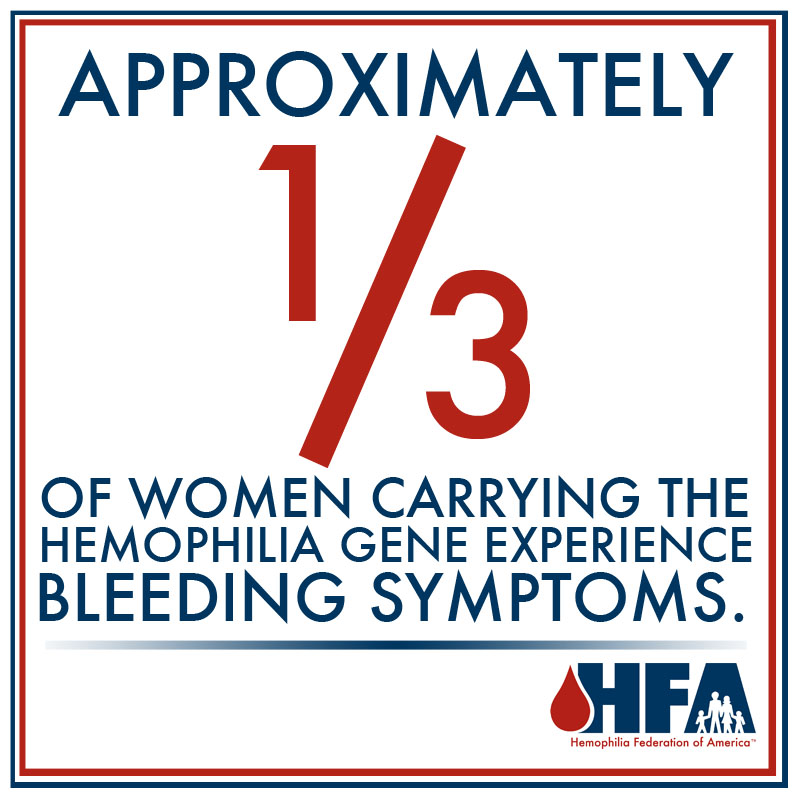While bleeding disorders like hemophilia and von Willebrand Disease (vWD) affect men and women, these conditions present unique issues for women because of heavy or abnormal bleeding during menstrual cycles and after childbirth. Many areas crucial to the diagnosis and treatment of bleeding disorders in girls and women are poorly understood. According to the CDC, it is estimated that nearly 1% of women in the United States may have a bleeding disorder and are unaware of their condition.
In 2004, The National Heart, Lung, and Blood Institute convened a working group of scientific experts to identify the research directions needed to address the problems in the diagnosis, treatment, and health management for women with bleeding disorders. The group determined that “undiagnosed and untreated bleeding disorders in females have a negative impact on their health and quality of life. Studies have documented increased morbidity due to excessive bleeding in girls and women.”Â
Fact: Girls Have Bleeding Disorders
Many are surprised that women are not only carriers of the hemophilia gene, but can present symptoms of hemophilia and are even clinically proven to have it. A carrier is a female who has the genetic mutation for hemophilia on one of her X chromosomes. Carriers with clotting factor levels of less than 50% may have symptoms similar to a male with mild hemophilia. They are often called symptomatic carriers or are diagnosed with mild hemophilia. A female who carries the hemophilia gene has the genetic mutation for it on one of her X chromosomes. Approximately one third of carriers experience bleeding symptoms.
Bleeding disorders among females may present special challenges because of the bleeding associated with menstruation and childbirth. Menorrhagia is abnormally heavy and prolonged menstrual periods, and is the most common symptom among females with a bleeding disorder. 
 A Symptomatic Carrier’s Perspective
My childhood was not much different than that of any of my friends. Since my older brother has severe hemophilia, for as long as I can remember, our family has always been active in the bleeding disorders community. My brother would treat at home and almost always participate in activities with the rest of the family. From swimming to skiing, Paul was, and is, just as fit as (if not more than) the rest of us.
Given my brother’s status, I was aware that I could possibly be a carrier, but I had never had any health situations that had truly “challenged” me . I will admit, I was also in a bit of denial, despite the fact that I had abnormal bleeding (nosebleeds and heavy menstrual cycles), but I never really wanted to face the facts.
Last year, I had a health emergency, and since I wasn’t aware of any condition, I was not properly treated. Although I had immediately explained my family history to the doctors, they were very hesitant to attempt any treatment. It wasn’t until I had bled for several hours straight that the doctors began treatment of clotting factor. It was because of this very stressful and scary situation that I learned to be aware of my condition as a carrier.
With this information, I can properly treat my bleeds by notifying my doctors of my condition. I try to make sure to wear a medical bracelet or have some information on me that notifies people in any case of emergency that I carry the hemophilia gene and have bleeds. This also makes me more aware of the issues I will deal with in my future when I decide to have children. I want to make sure I am fully prepared for what I could possibly have to deal with if I have a child with hemophilia.
I am lucky enough to have a family that is very supportive and encourages me to be a proud person no matter what my circumstance. Since my diagnosis, I have become more active in the community and am very interested in meeting other women with my condition. I think it is really important that other women in my situation, especially female siblings, get tested early so that they are not caught unaware of their medical situation like I was.
In the past, hemophilia has been seen as a “man’s disease,” when in reality, many women deal with it as well. I think it is extremely important for women with low factor levels to continue to come together to share stories. It is empowering and helps to prevent a crisis from occurring.
  Dana Braysaw, 24 years old, symptomatic carrier, currently resides in Northern Virginia.
Dana Braysaw, 24 years old, symptomatic carrier, currently resides in Northern Virginia.
Common Symptoms of Females with a Bleeding Disorder:
- Frequent nosebleeds
- Prolonged bleeding from minor cuts
- Easy bruising (unexplained bruising)
- Excessive bleeding with dental work or tooth extraction
- Menorrhagia (abnormally heavy and prolonged menstrual period)
- Post-partum bleeding (excessive bleeding after giving birth)



